Examining Glass on Beaches: Origins and Impact
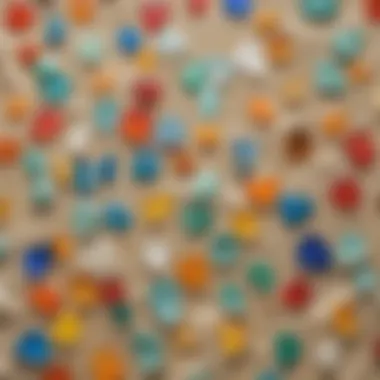
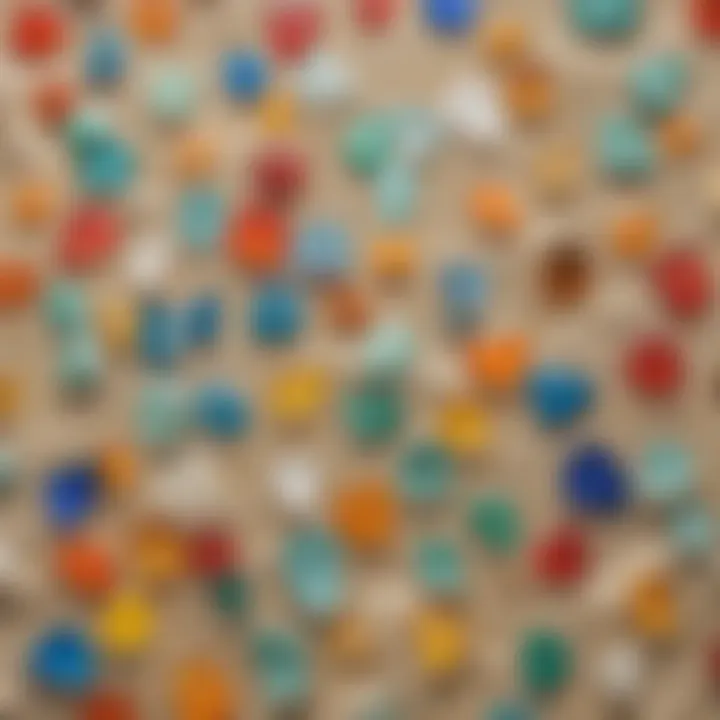
Intro
Glass on the beach presents an intriguing blend of beauty and curiosity. From glimmering shards worn smooth by the relentless surf to vibrant colors shaped by years of weathering, the phenomenon captivates both casual beachgoers and seasoned beachcombers alike. But where does this glass originate, and what stories do these fragments tell? Understanding the presence of glass on beaches goes beyond mere aesthetics; it connects us to our environment and reflects human behaviors, practices, and histories.
In the broad expanse of sandy shores, glass pieces can be found, each one carrying a narrative of its own. Some might have originated from discarded bottles after a picnic long forgotten, while others may stem from shipwrecks or coastal festivities that left their mark behind. As waves crash upon the shore, they transform sharp edges into blurred silhouettes. This metamorphosis raises questions about the environmental impact and cultural significance of glass fragments—issues we ought to consider while appreciating their allure.
In this exploration, we will delve into the origins of beach glass, plotting the journey of these pieces from their human-made beginnings to their final resting place on coastal landscapes. We will also discuss the ecological footprints we leave behind and how they interlace with the artistry that beach glass inspires. Moreover, we shine a light on the efforts of beachcombers and environmentalists in addressing the challenges posed by glass debris.
Join us as we unfold the layers hidden within this phenomenon and develop a richer understanding of humanity’s relationship with our precious coastlines.
Prelude to Beach Glass
The world of beach glass is not just a collection of colorful, smooth pieces of glass left behind by the tides; it tells a story deeply rooted in both culture and environment. Understanding beach glass opens a window to appreciating natural beauty and human influence on coastal ecosystems. For those who enjoy the coastal lifestyle—surfers, paddleboarders, kitesurfers, and instructors alike—this subject resonates with the experience of being on the shore, where the remnants of human activity blend mysteriously with nature's handiwork.
Definition and Characteristics
Beach glass is generally defined as glass that has been weathered and polished by the sea or river, resembling small gemstones. It often varies in color due to the original sources; beachcombers may find shades like green, brown, clear, or more exotic hues like cobalt blue or amber, which makes searching for these treasures an exciting pursuit.
The process of creation involves various stages:
- Origin: Most beach glass comes from discarded bottles, jars, or any glass items that end up in coastal waters.
- Weathering: Over time, the waves and sand wear the glass down, smoothing sharp edges and creating a frosted appearance.
- Size Variation: Sizes can range from tiny flecks to larger pieces, each telling a history of its former life.
An intriguing aspect is the texture. Some have a shiny, glossy surface, while others might feel matte and rough, giving them unique tactile qualities. Collectors and artists often prize beach glass for its aesthetic appeal.
Cultural and Historical Context
Historically, the presence of beach glass has woven itself into many cultures. In some coastal communities, local folklore speaks of finding beach glass as a sign of good fortune or a safe return from the sea. This belief reflects a deep connection between people and their natural surroundings.
Moreover, beach glass has been incorporated into various artistic endeavors—jewelry making, mosaics, and decorative crafts. As more people venture into beachcombing for artistic inspiration, the cultural significance of these fragments continues to grow. For surfers and paddleboarders, encountering these beautiful pieces of history serves as a reminder of the intricate relationship between nature and human activity.
"Beach glass serves as a beautiful reminder of resilience, transforming discarded materials into treasures."
Understanding the role of beach glass, both as an ecological artifact and a cultural gem, enhances our beach experience and encourages responsible engagement with our coastal heritage. As we delve into its formation and implications on the environment, the importance of this topic becomes even clearer.
Formation and Sources of Glass on Beaches
Understanding the formation and sources of glass found on beaches is essential. It's not simply about discovering shiny pieces of debris; it's about recognizing the interplay of human activity and nature. Each shard holds a story, reflecting the interaction between our lifestyles and environmental processes. The way glass reaches coastlines can enhance coastal ecology and raise awareness about sustainability—a vital consideration for those who cherish aquatic sports like surfing or paddleboarding.
Human Contributions to Beach Glass
Human activity plays a significant role in the existence of beach glass. From bustling seaports to solitary picnics by the shore, glass often becomes an unintended consequence of our everyday actions. Whether bottles, jars, or other glassware, these items often end their life cycle in the ocean. Discarded improperly or lost during recreational activities, these fragments are ground together by the waves and sand, creating the beautiful pieces beachcombers often treasure.
The effects of urban development near coastlines can't be overlooked. Construction projects tend to amplify debris, including glass, which the tides then carry to the beach. Even casual beachgoers, while enjoying a sunny day, can unintentionally contribute to the problem if they aren’t careful with their waste.
"The true beauty of beach glass lies not just in its aesthetics, but in its sculpted journey from waste to wonder."
This transformation also highlights a critical consideration for our communities. Awareness is needed not just for the look of beach glass, but for the implications of plastic and other waste, which often accompany glass on our beaches.
Natural Processes Leading to Glass Formation
Whereas human influence is overt, nature has its own method for crafting glass treasures. Over years, ocean waves and currents take on the role of artists, wearing down sharp edges and transforming discarded glass into the smooth, frosted pieces that people admire. The natural elements, salt, and sand contribute to this remarkable process.
The friction caused by sand and stones abrades the glass surfaces, creating those characteristic rounded edges seen in beach glass. It is almost poetic to think how each piece has undergone layering and erosion, transforming something unpleasant into coastal artwork.
Some natural factors include:
- Wave Action: Constantly rolling back and forth, waves polish the glass, giving it a smooth surface.
- Weathering: Rain and the ebb and flow of coastal influences wear down glass over time.
- Temperature Changes: Extreme conditions—from scorching sun to freezing nights—can contribute to the breaking down of glass into smaller shards.
These factors play a massive role in producing unique beach glass, often varying in color and shape based on where they originated. Surfers and paddlers often notice these remnants when they’re catching waves or relaxing on the shore, adding an unexpected touch of beauty to their outdoor experience.
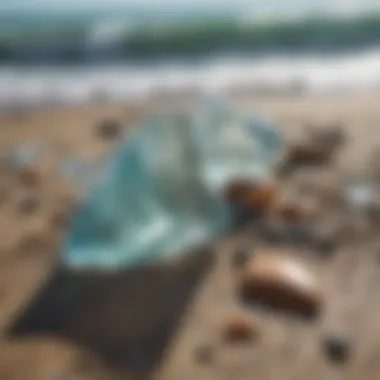
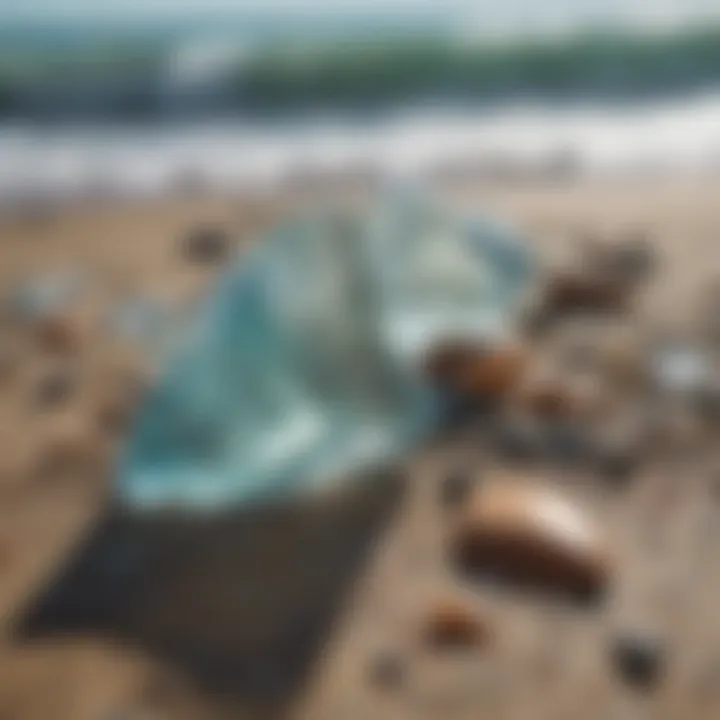
In essence, human actions and the relentless forces of nature both contribute to the existence of beach glass on our shores. It’s a collaborative narrative between us and the ocean that tells of our past and natural history, encouraging even those deeply involved in ocean sports to reflect on their impact and experiences in these cherished environments.
Environmental Impact of Beach Glass
The presence of beach glass on our shores is more than a mere aesthetic curiosity; it bears significant ecological implications. Understanding the conditions under which glass debris accumulates can illuminate the impact on coastal environments. In this section, we will explore how these shards affect marine life, coastal habitats, and ultimately, the health of ecosystems that depend on the balance of their components.
Effects on Coastal Ecosystems
Beach glass can be both a burden and a unique part of coastal ecosystems. At first glance, the colorful and oftentimes smoothened pieces might seem harmless. However, the reality is more complex.
- Habitat Disruption: Large amounts of glass waste may bury vital habitats. For example, sea turtles depend on sandy beaches not just for laying eggs but also for finding food. When glass accumulates, it can change these environments, making it difficult for marine creatures to thrive.
- Pollutant Accumulation: Glass, though inert, can host pollutants from various sources. The fragments can act as a medium for harmful substances, like plastics or chemicals, leading to increased toxicity levels in the vicinity. The organisms that consume these contaminated particles can subsequently suffer from these pollutants, impacting their health and reproduction.
- Microhabitats: On the positive side, some marine life may find refuge in the spaces between glass pieces. Small organisms, like crabs or fish fry, can use these nooks as shelter from predators. Yet, this facade of safety is often overshadowed by the longer-term hazards posed by the glass itself, especially when it breaks down into smaller shards.
In summary, the interactions between beach glass and coastal ecosystems showcase a fascinating dance of complicity and challenge, raising questions about mortality, survival, and environmental health.
Effects on Public Safety and Beachgoers
When discussing beach glass, we cannot overlook how it affects the human experience at the beach. The allure of scavenging for colorful pieces often glosses over potential risks.
- Injury Risks: The most immediate concern is, of course, the danger of injury. Shards of glass, even those polished by waves, can cause cuts or puncture wounds. This can pose a particular threat to children who may not be as vigilant in avoiding sharp objects.
- Awareness and Education: Many beachgoers may not recognize the risks associated with beach glass. Informational signage in high-traffic areas can play a pivotal role. Encouraging visitors to wear shoes, for instance, can minimize injuries and foster a culture of safety along the coast.
- Beach Cleanups: Grassroots efforts to collect and dispose of glass responsibly are crucial. Community engagement in cleanup initiatives can transform the relationship between beach glass and public safety. Not only does this preserve the beach for recreational use, but it also promotes a sense of stewardship among residents and visitors alike.
By analyzing both the ecological ramifications and the risks to beachgoers, it becomes evident that a comprehensive approach is essential. Bringing awareness to the complexities surrounding beach glass can empower individuals to enjoy the beauty of their coastal environments responsibly.
Artistic Applications of Beach Glass
Artistic applications of beach glass reveal a captivating dimension of this unique material, showcasing not only its visual appeal but also its potential for sustainable creativity. This discussion sheds light on the intrinsic value that beach glass holds for artists and crafters alike, offering an alternative to conventional materials, along with a notable story behind each fragment washed ashore.
Beach Glass in Art and Crafting
Beach glass, often boasting vivid colors such as aqua, emerald green, and amber, serves as an inspiring element for various art forms. Artists have leveraged the soft, smooth textures of these glass pieces, which transform through exposure to the elements, to create an array of artwork.
- Jewelry Making: One of the most popular uses of beach glass is in jewelry design. Handmade necklaces, earrings, and bracelets often incorporate these colorful shards, attracting collectors and admirers. Not only do these pieces carry an aesthetic touch, they also tell tales of the ocean's journey, creating a deeper connection between the creator and the wearer.
- Mosaics and Wall Art: Crafters frequently utilize beach glass in mosaics, merging various colors and sizes to form intricate designs. Whether it be flower patterns or abstract shapes, the versatility of beach glass allows for both indoor and outdoor decorations, making it ideal for gardeners and home decorators.
- Functional Art: Beyond aesthetic appeal, artisans are integrating beach glass into practical items like tabletops, coasters, and other household goods. Such pieces reflect a fun balance between beauty and function, all while maintaining an eco-conscious ethos.
Incorporating beach glass into art can also invite environmental discussions, emphasizing the need to appreciate and protect coastal ecosystems. Each work of art can become a dialogue starter about ocean stewardship, prompting viewers to ponder their environmental impact.
The Role of Beach Combing in Creative Expression
Beach combing not only serves as a leisurely activity but also acts as a treasure hunt for creative souls. The thrill of uncovering unique pieces of glass encourages individuals to explore their surroundings while engaging in mindfulness, often yielding surprising finds that fuel artistic inspiration.
Combing beaches allows one to forge a strong connection with nature. Thinking critically about the glass’s origin blends the fields of art and environmental consciousness. This journey becomes more than just a collection of fragments; it evolves into a narrative that speaks to the individual's experiences at the shore.
- Developing Artistic Techniques: Collecting beach glass provides artists with the chance to research and refine their skills. Many artists experiment and innovate with various forms of media by integrating glass fragments into traditional forms like painting or sculpture, enriching their creative portfolio.
- Community Engagement: Beach combing can promote a sense of community. Local workshops often spring up, allowing participants to share techniques and insights, fostering both collaboration and camaraderie. Through such collective experiences, participants often form deeper connections both with the art and the environment.
- Environmental Awareness: As artists engage in beach combing, there’s often an underlying theme of environmental activism. Many embrace the opportunity to educate others on the importance of keeping beaches clean and understanding the environmental factors that lead to glass accumulation along shores.
"The beauty of beach glass lies not just in its allure but in the stories it carries. Each piece is a narrative—worn, shaped, and redefined by natural forces."
In summary, the artistic applications of beach glass encapsulate the intersections of creativity, sustainability, and nature. The importance of engaging with this material is profound, as artists and beachcombers alike contribute to a greater understanding of both the oceans and local communities, creating meaningful connections along the way.
The Perspective of Environmentalists
When diving into the subject of beach glass, it’s crucial to consider the viewpoint of environmentalists. These individuals do not merely ponder the aesthetic beauty of glass shards scattered along ocean edges; they engage in serious discourse about the ecological ramifications of this phenomenon. Here, we explore the significant elements of their perspective, ranging from cleanup initiatives to the need for raising awareness among both locals and visitors.
Cleanup Initiatives and Strategies
Cleanup efforts are paramount in addressing the impact of glass on beaches. Environmentalists often spearhead initiatives that focus on preserving coastal ecosystems while promoting safe enjoyment of these natural spaces. The presence of glass shards can pose dangers to both wildlife and beachgoers. Therefore, various strategies have emerged:
- Organized Beach Cleanups: Local organizations, sometimes supported by larger environmental groups, often set up regular cleanup events. Community participation fosters a sense of ownership of public spaces, encouraging individuals to take active roles in maintaining them.
- Adopting Beaches: Numerous environmentalist organizations have started adopting specific sections of coastlines. This not only helps in cleaning efforts but also promotes accountability in managing the local environment over time.
- Educating Volunteers: Alongside removing debris, environmentalists often share information with volunteers about the ecological impact of glass and why it matters to remove it. This cultivates a deeper understanding among community members.
These strategies not only keep beaches pristine but also reduce the risk of injury from sharp glass pieces. Collaboration with local authorities enhances the reach and effectiveness of these clean-up initiatives, making a tangible difference.
Raising Awareness and Education


Education is a cornerstone in the effort to responsibly manage glass on beaches. Environmentalists work to raise awareness about the implications of beach glass, guiding both regular visitors and casual beachgoers to engage in sustainable practices:
- Workshops and Seminars: Many organizations host events that delve into the history of beach glass and its effects on the ecosystem. Workshops often include hands-on activities that let participants see the implications first-hand.
- Social Media Campaigns: Leveraging platforms like Facebook and Reddit, environmentalists share information, promote events, and create discussions around the environmental concerns tied to glass on beaches. Visual storytelling can have powerful effects in reaching a wider audience.
- Collaboration with Educational Institutions: Partnering with schools and universities can foster a culture of environmental stewardship from a young age. Engaging students with the topic ensures that the next generation is informed and motivated to take action.
"A knowledgeable community becomes a powerful force in protecting nature. Awareness leads individuals to make choices that benefit the environment."
Through these educational endeavors, beachgoers can better appreciate the importance of maintaining coastal integrity. Ultimately, environmentalists aim to forge a connection between people and nature, reminding everyone that even the most seemingly innocuous glass shards carry significant weight in the broader context of ecological health.
Cultural Significance of Beach Glass
Beach glass is more than just a discarded fragment of human history; it represents a unique blend of nature, culture, and history that resonates with many people. Exuding a certain charm, these colorful shards of glass have become cherished artifacts for beachcombers and artists alike, symbolizing the intersection of human impact and natural transformation. In this section, we will delve deeper into the cultural significance of beach glass, illustrating its role in traditions, folklore, and community engagement.
Traditions and Folklore Surrounding Beachcombing
Beachcombing, the act of searching for treasures along the shoreline, has deep roots in many coastal cultures. Different regions have developed their own folklore surrounding beach glass, which often reflects the stories of the land and sea. For instance, there’s a charming belief in some fishing communities that finding a piece of sea glass signifies good luck or denotes a bountiful catch ahead. These narratives serve to connect people with their environmental surroundings and imbue a sense of shared heritage.
Traditionally, beachcombers have shared tales of mystical experiences that occur during their walks along the water. Many believe that the sea has a way of orchestrating encounters that are more than coincidental. For example, the gentle finding of a rare blue piece of glass might be heralded as a sign from the ocean, cherished and respected. Such sentiments help foster a deep-rooted connection to nature, making each search not just a hunt for artifacts, but a communion with the past and the sea itself.
As beachcombers share their findings and stories, community bonds are often reinforced. Whether recounting encounters around a beach bonfire or sharing collections on social media platforms like Reddit, these shared experiences deepen friendships and create a sense of belonging.
Community Engagement and Connection
The presence of beach glass also sparks various community-driven initiatives. Groups often come together not just to clean beaches but to celebrate the beauty these glass fragments bring to their coastal environments. This practice is about more than just tidying up; it's about acknowledging the cultural stories that come with these pieces. In instances where beach glass is abundant, local artisans may hold workshops to recycle and craft jewelry, art pieces, or home decor using these remnants.
Such community events serve various purposes:
- Environmental stewardship: Not only do participants clean up litter, but they also encourage others to value their coastal ecosystems more.
- Creative expression: By transforming beach glass into art, locals celebrate their environment and demonstrate the intersections of nature and culture.
- Social connections: Community events bring together outsiders and locals, stirring conversations and fostering friendships.
"Finding beach glass turns the casual stroll into a treasure hunt, enriching the walk with stories and connections to the sea and the community."
Guidelines for Beachgoers
When it comes to enjoying a day at the shore, understanding how to navigate the presence of beach glass is critical. This section will shed light on why it's essential for beachgoers to be mindful of their surroundings and the implications of collecting or interacting with glass fragments on the beach. Not only does this guide offer safety tips, but it also encourages a respectful approach to the environment, which ultimately benefits both users and natural habitats.
Safety Tips for Handling Beach Glass
Beach glass carries an undeniable allure, reflecting light in captivating ways, but it's important to remember that not all shimmers hold the same charm. Here are some vital safety tips to consider while handling beach glass:
- Wear protective footwear: Avoid thin flip-flops; sturdy shoes can shield your feet from sharp edges.
- Examine carefully: Always check the glass pieces for sharp points or potential contamination. Mouth infections from cuts can be nasty and sneaky.
- Use gloves: A simple pair of gloves can provide an additional layer of protection against both cuts and sharp glass edges while handling larger shards.
- Stay hydrated: Sun exposure can sneak up on you. Remember to drink water regularly to prevent dehydration, especially after scavenging for glass.
"Caution is paramount when enjoying the beauty of beach glass. Each step on the sand should be intentional."
By adhering to these guidelines, beachgoers can significantly minimize risk while relishing the coastal treasures they unearth.
Respecting Natural Habitats
The importance of respecting natural habitats cannot be overstated. Beach ecosystems are intricate webs of life, and a thoughtful approach to beach glass can preserve this balance. Here are some key considerations:
- Leave some glass behind: While it's tempting to fill your pockets with glass, allowing some to remain helps ensure that others can also enjoy this unique experience.
- Avoid disturbing wildlife: If you spot nests or habitats, steer clear of them. Beach areas are often vital for nesting birds and other creatures.
- Dispose of trash properly: If you do carry out any litter you find, ensure glass fragments are placed in designated waste bins to prevent injury to other beachgoers and wildlife.
- Educate others: Spread the word about the importance of respecting habitats and handling beach glass safely, fostering a community of conscientious beach lovers.
By being mindful of the ecological implications and maintaining a responsible attitude, beachgoers contribute to the long-term health of coastal ecosystems. This not only enhances their beach-going experience but also nurtures a sustainable relationship with nature.
Consider the simple pleasure of a beach day intertwined with a sense of duty towards our environment. Learning to strike that balance is key.
Future Perspectives on Beach Glass
The presence of glass on beaches is not merely a topic of aesthetic curiosity; it embodies a complex interplay of ecological, cultural, and artistic dimensions. As we tread into the future, understanding these dynamics becomes paramount. The significance of discussing future perspectives on beach glass lies in identifying potential trends that will shape our interactions with this unique element. It reveals how not just the collectors or artists, but society at large responds to the challenges and opportunities presented by beach glass.
Trends in Art and Collecting
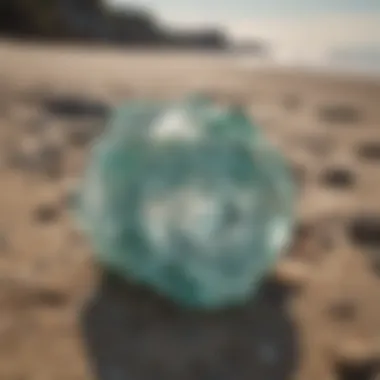
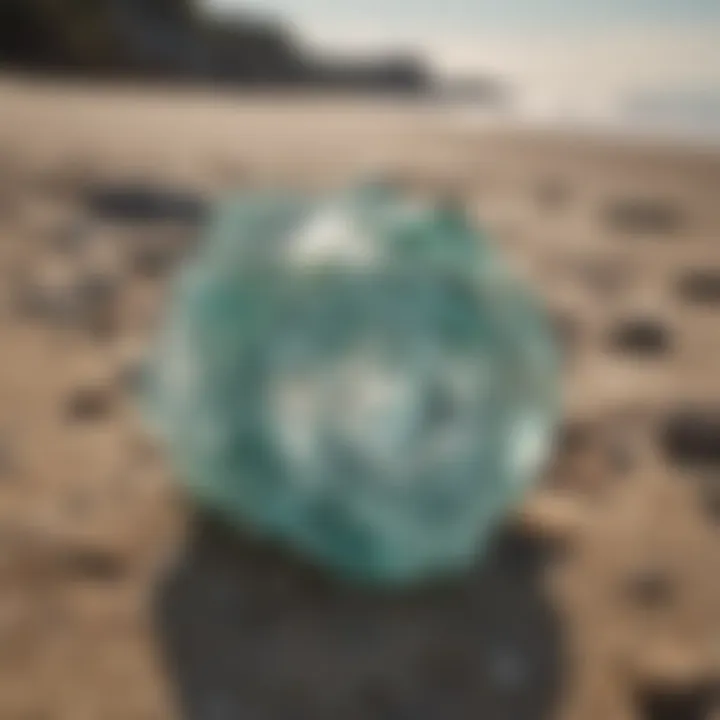
In recent years, there has been a noticeable uptick in interest surrounding beach glass, particularly in the realm of art and collecting. Artists are drawn to its beauty. The smooth, frosted surfaces and myriad colors captivate crafters and collectors alike. From jewelry to intricate mosaics, the transformation of leftover waste into stunning art pieces speaks to a culture increasingly focused on upcycling and sustainability.
Moreover, social media platforms, especially those like Instagram and Facebook, have aided in spreading this enthusiasm. There, artists showcase their creations and beachcombers flaunt their finds. This has fostered vibrant communities dedicated to beach glass exploration. Collaborations between artists and environmental organizations have also arisen, pushing for art that raises awareness about coastal clean-up efforts, emphasizing the connection between creativity and environmental stewardship.
- This growing trend not only encourages individual creativity but serves as a reminder of our collective responsibility to cherish and protect our beaches.
- Collectors are not merely hoarders but curators of local history, enabling the narrative of communities to unfold through the artifacts they gather.
In essence, the future of beach glass as an artistic medium is bright, attracting ongoing interest while promoting an ethos of environmental consciousness.
Research Directions and Environmental Dialogues
The conversation about beach glass must extend beyond art and collecting into significant dialogues surrounding research and environmental impact. Scholars and environmentalists are increasingly scrutinizing the sources and ecological ramifications of glass waste on our coastlines. Recognizing how debris interacts with marine ecosystems is a crucial step in managing its presence.
Research initiatives are needed to assess how beach glass affects local wildlife, especially in terms of ingestion or entanglement. Furthermore, studies should explore the beneficiation of beach glass through recycling processes that convert waste into usable products, reducing overall waste in landfills and oceans.
- Future studies might include:
- Analyzing the long-term ecological effects of glass debris in aquatic environments.
- Investigating best practices in cleaning methods that conserve both glass and natural habitats.
- Establishing educational programs aimed at fostering respect for coastal ecosystems among surfers, paddleboarders, and kitesurfers.
"The relationship between beach glass and the environment prompts critical inquiries into human behavior influencing coastlines, pointing towards the need for better conservation strategies."
Case Studies from Notable Locations
Famous Beaches Known for Glass Collecting
When diving into the world of beach glass, certain shores stand out as paradise for collectors and enthusiasts alike. These locations don't just have stunning vistas; they boast a rich tapestry of glass artifacts waiting to be discovered.
- Glass Beach in Fort Bragg, California - Often touted as the most famous for its abundance of sea glass, this locale transformed from a dump site into a breathtaking natural art installation. As the waves continually crash against the shore, decades' worth of discarded glass has been polished to smooth edges, creating a striking spectacle that draws visitors from around the globe. The diversity in colors—from emerald greens to frosty whites—offers a glimpse into its storied past.
- Probier Island, Maine - A lesser-known gem, this spot offers a delightful blend of granite shores and frothy surf. The island's unique geological features contribute to a special kind of beach glass known as ‘tumbled glass’—essentially glass that has been smoothed over time. Locals often promote sustainable collection through community arts initiatives, emphasizing mindfulness in a treasure hunt.
- Bottle Beach, Washington - It’s like walking through a time capsule filled with nostalgia. This beach is famous for its abundance of glass bottles washed ashore, providing a unique thrill for those intrigued by history and geology. Weather-worn bottles from eras gone by tell tales of maritime adventures, making every find a piece of art and history intertwined.
Comparative Analysis of Coastal Responses
Each remarkable location evokes distinct strategies and contexts related to glass as an ecological concern. While the beauty of beach glass enchants many, the need for pragmatic responses to glass debris is a pressing issue for coastal communities.
- Environmental Strategies - Coastal towns with significant glass presence have birthed initiatives aimed at managing the glass. For example, Fort Bragg has made efforts to keep Glass Beach thriving by organizing community cleanups that not only remove excess glass but also educate the public about maintaining environmental balance. They promote the idea that preserving beauty also means safeguarding the ecosystem.
- Cultural Approaches - In locales like Maine, cultural responses have been born from community engagement in artistic expressions. Workshops on glass artistry not only channel collected glass into beautiful works but also foster a spirit of sustainability. It brings residents and visitors together, creating a shared sense of ownership over their natural resources.
"What adds value to these beach glass treasures is the experience of finding them. Collectors aren't just picking up pieces of glass; they are piecing together stories from myriad lives and eras."
- Tourism Considerations - Beaches, notably those renowned for glass, attract tourists. However, coastal managers must balance visitor engagement with preservation. Popular places often see foot traffic so heavy that education on etiquette and sustainability becomes paramount. Temporary installations or signage about responsible collecting enrich the experience while protecting the delicate ecosystems.
In combination, these case studies and their analysis highlight not just the allure of collecting beach glass but also the environmental dialogues ongoing in coastal communities. From California’s bustling shores to Maine's quiet solitude, each location offers a unique narrative informing both collectors and coastal caretakers.
Understanding the delicate balance between appreciation and preservation can ultimately lead to richer experiences, reminding us that while we admire the ocean’s bounty, our responsibility toward it remains like glass—fragile yet beautifully resilient.
Culmination
The exploration of beach glass is far from a simple tale of broken glass fragments adorning sandy shores. Instead, it embodies a multifaceted narrative rich with ecological, cultural, and artistic dimensions. In this section, we encapsulate the various threads that run throughout the article, shedding light on why understanding beach glass matters not just for beach enthusiasts but for everyone who interacts with coastal environments.
Summarizing the Intricacies of Beach Glass
Beach glass serves as a window into both human activities and natural forces. It is essential to recognize how anthropogenic contributions, including littering and improper waste management, have shaped the presence and characteristics of glass found on the beach. The typical frosted appearance is a result of time spent tumbling in the ocean's embrace, demonstrating an ever-evolving dance between decay and beauty.
Moreover, examining beach glass also invites us to reflect on broader environmental issues, such as marine debris and its impact on coastal ecosystems. Remember, while picking up a beautiful piece may seem harmless, it is crucial to understand the larger context of one's actions.
Ultimately, beach glass is a testament to cultural narratives spanning generations. Each fragment carries stories of the past, bridges to local traditions, and symbols of our shared responsibility for the planet. Tracking down unique specimens not only stimulates personal creativity but also fosters an appreciation for natural beauty.
Encouraging a Responsible Appreciation of Coastal Beauty
Being enchanted by the allure of beach glass is one step; however, developing a responsible approach to its collection and enjoyment is equally critical. As surfers, paddleboarders, kitesurfers, and instructors revel in coastal adventures, they must embrace a mindful attitude towards their surroundings.
Here are some key considerations:
- Engage with Awareness: Before reaching for a piece of beach glass, consider its origins. Each shard can tell a story and reflects human behavior toward the ocean. Picking up glass while ignoring the overarching littering issue can be paradoxical.
- Respect Natural Habitats: Many coastal regions harbor fragile ecosystems. By contributing to sustainable practices, beachgoers can help protect the native flora and fauna while enjoying their time at the shore. Leaving the beach cleaner than found is always a point of pride.
- Connect and Educate: Informing others about the significance of beach glass not only elevates awareness but also nurtures a community committed to preserving coastal beauty. Sharing knowledge fosters a culture of respect towards nature.
"The beach glass we collect is a reminder of what we’ve tossed away and what the ocean has returned to us, reshaped and redefined. Our responsibility is to ensure that these stories continue for generations to come."
By encouraging a responsible appreciation of coastal beauty, surfers, paddleboarders, and all beach lovers can transform their love for beach glass into a commitment toward a healthier ocean and a more vibrant coastline.



